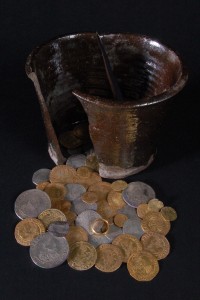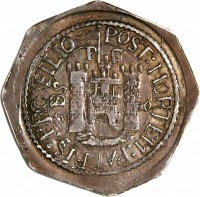 Dr. Owen Johnson was looking at a hole dug by builders in his back yard in the town of High Ackworth, near Pontefract, West Yorkshire, last summer when he saw the rim of a ceramic pot sticking out of the dirt. He tried to dig it out, but it split in two and a torrent of gold and silver coins spilled out “like a slot machine,” as the good doctor put it. The final tally was almost 600 gold and silver coins dating to the 1640s and a gold ring inscribed, “When this you see, remember me.”
Dr. Owen Johnson was looking at a hole dug by builders in his back yard in the town of High Ackworth, near Pontefract, West Yorkshire, last summer when he saw the rim of a ceramic pot sticking out of the dirt. He tried to dig it out, but it split in two and a torrent of gold and silver coins spilled out “like a slot machine,” as the good doctor put it. The final tally was almost 600 gold and silver coins dating to the 1640s and a gold ring inscribed, “When this you see, remember me.”
The coins were buried near what look like the remains of an old post, so Dr. Johnson believes the treasure might have been buried by a worried Royalist hiding his worldly goods from marauding Parliamentarians during the Civil War. The coins have a total face value of £85 ($135), the equivalent today of about £7,000 ($11,000). (The UK National Archives website has an awesome historical currency and buying power converter.) Those coins would have bought far more during the mid-17th century than $11,000 could buy you today. Of course their historical value is much higher, and probably the plain precious metal weight is too.
As expected, the coins and ring have been declared official treasure, at the coroner’s inquest at Wakefield Coroner’s Court on Tuesday. Since they are precious metals older than 300 years, according to the 1996 Treasure Act the artifacts are now property of the Crown. The next step is to assess their market value. Museums will then be given first bite at the apple, but they have to raise the money to secure the treasure. The money is usually split between the finder and the property owner, who in this case are the same person.
Local government officials are hoping the coins and ring will stay in the area, perhaps on display at the Pontefract Museum.
Dr Johnson said: “Pontefract Museum is very interesting but it could do with some highlights and this would definitely be a highlight, which would be good because Pontefract’s history is sometimes undervalued.”
Lisa Dodd, Wakefield Council’s service director for sport and culture, added: “We believe these items have been in our district since the 1600s, making them a real part of this district’s rich history. It would be a great shame to not do all we can to try and keep the treasure in its rightful home for future generations to enjoy.
“The Wakefield district has a superb, nationally renowned heritage and Pontefract Museum would be a fitting home for the treasure.”
 Pontefract played an important role during the Civil War. Pontefract Castle, a powerful ducal stronghold since the Norman invasion and the place where King Richard II was imprisoned and died after his forced abdication, was besieged by Parliamentarian forces no fewer than three times between 1644 and 1649. Cromwell described it thus after the second siege:
Pontefract played an important role during the Civil War. Pontefract Castle, a powerful ducal stronghold since the Norman invasion and the place where King Richard II was imprisoned and died after his forced abdication, was besieged by Parliamentarian forces no fewer than three times between 1644 and 1649. Cromwell described it thus after the second siege:
[Pontefract Castle] is very well-known as one of the strongest inland garrisons in the kingdom; well-watered; situated on rock in every part of it; and therefore difficult to mine. The walls are very thick and high, with strong towers; and if battered, very difficult of access, by reason of the depth and steepness of the graft.
He knew whereof he spoke. Pontefract Castle would prove to be literally the last Royalist line of defense. Pontefract was still fighting for the Royalist cause for months after the war ended everywhere else. The third siege began in August of 1648. It was still going strong on January 30th, 1649, when King Charles I was beheaded. The Rump Parliament that had executed the king for treason declared the monarchy abolished on February 7th.
 The Royalist garrison at Pontefract Castle simply proclaimed the regicided king’s son King Charles II and fought on in his name for almost two months. They even minted coins in the name of King Charles II, inscribed with the motto “Post mortem patris pro filio” meaning “After the death of the father, support the son.” The castle finally fell on March 24th, 1649, and was demolished by Parliament that summer. Only ruins remain now.
The Royalist garrison at Pontefract Castle simply proclaimed the regicided king’s son King Charles II and fought on in his name for almost two months. They even minted coins in the name of King Charles II, inscribed with the motto “Post mortem patris pro filio” meaning “After the death of the father, support the son.” The castle finally fell on March 24th, 1649, and was demolished by Parliament that summer. Only ruins remain now.
After the Restoration of the monarchy in 1660, Pontefract made “Post mortem patris pro filio” its official motto which it remains to this day.